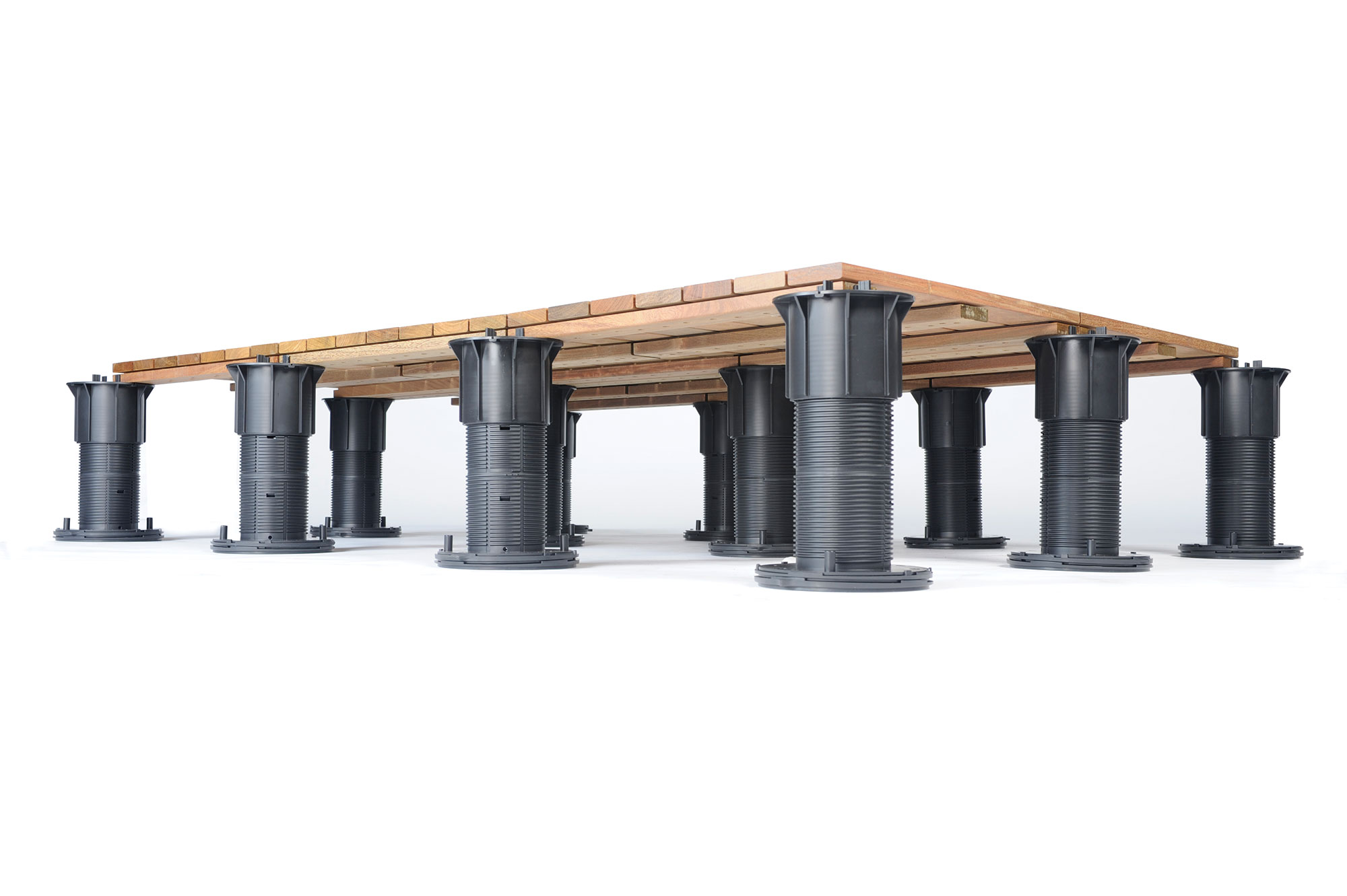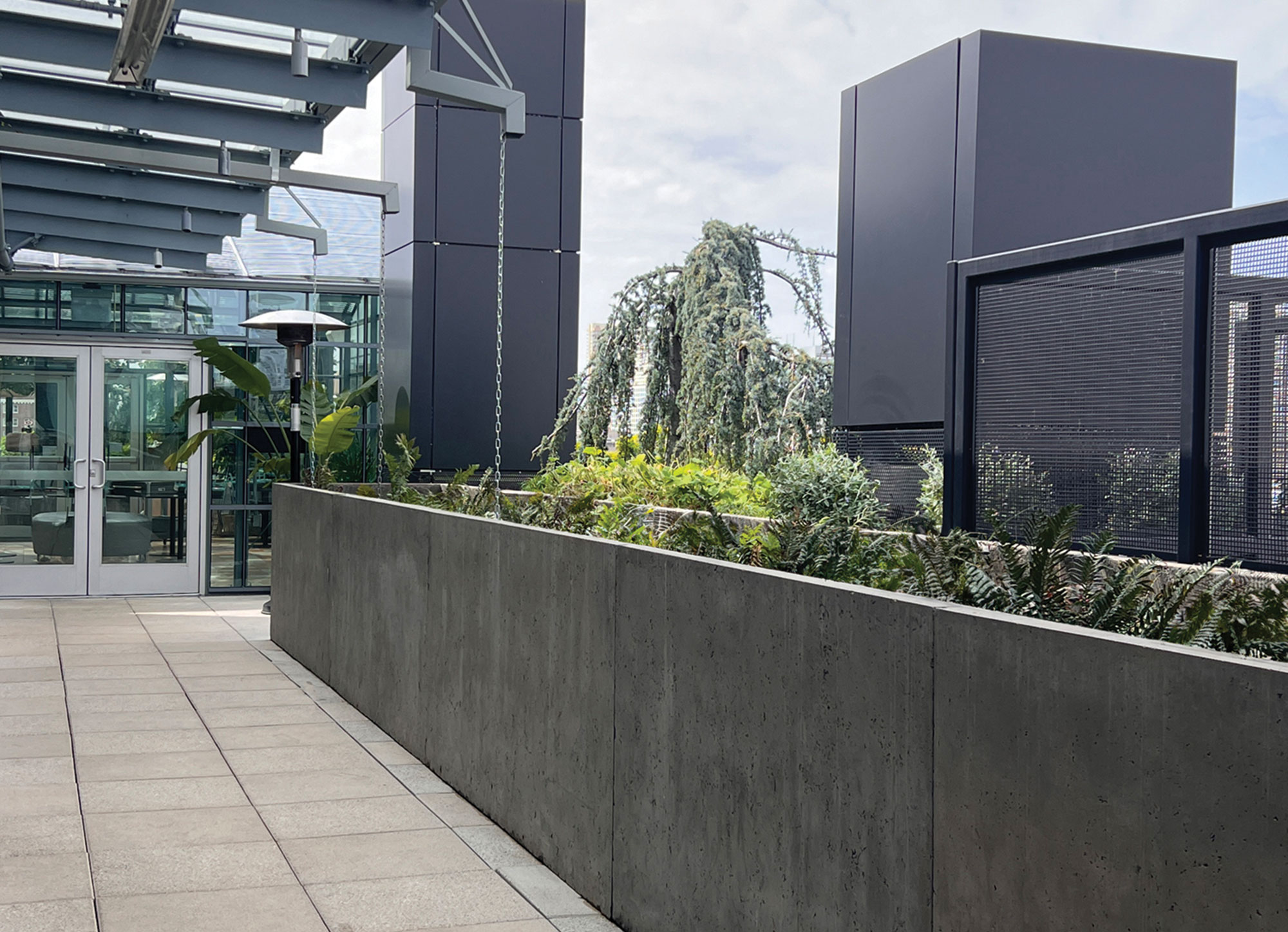Landscape Architecture – Designing with Nature
Combining the natural environment with the built environment
Sponsored by Bison Innovative Products and Tournesol Siteworks | By Peter J. Arsenault, FAIA, NCARB, LEED AP

Photo courtesy of Tournesol Siteworks
Incorporating vegetation with buildings provides dynamic landscape design opportunities and offers many sustainability benefits for people’s health and well-being.
The natural environment is our well-developed home on earth which offers physical, psychological, and emotional benefits to people. The built environment is our human response to create shelter and spaces that are practical and beautiful to live, work, and play in. The intersection of these two environments is found in landscape architecture – a combination of built and natural design. In urban, rural, and suburban settings, landscape architecture can turn an otherwise unused or abandoned piece of land into a natural looking setting that allows for vibrant activities or peaceful repose. In and around buildings, landscape architecture can create outdoor spaces that complement the building designs, streetscapes, or rooftops to add nature and beauty to an otherwise harsh hardscape. This course will explore some of the current ways that landscape architecture is being combined with building architecture to produce a coordinated, functional, healthy, and appealing total result.
LANDSCAPING DESIGN TRENDS
Design professionals of all types, including architects and landscape architects, are often concerned with considerations and strategies for designing outdoor spaces that fulfill the end users' health, safety, and welfare needs. At the same time, they seek to minimize the environmental impacts of those outdoor spaces by evaluating the sustainability attributes of their design by focusing on compliance with third-party criteria such as LEED, SITES, and WELL rating systems. Toward these ends, at least three current trends in landscape architecture support the design of successful, sustainable outdoor spaces.
- Biophilic Design: Wilson and Kellert define Biophilic Design as "the deliberate attempt to translate an understanding of the inherent human affinity to affiliate with natural systems and processes - known as biophilia - into the design of the built environment.” There are many ways to incorporate biophilic elements into a building’s design—through a visual connection to the outdoors, incorporation of natural elements, or expanding the indoors to the outdoors. Many projects that incorporate biophilic design elements also have sustainability and wellness goals designed to benefit human health and healing, increase productivity in work environments, and improve the overall quality of life by lowering stress levels.
- Greening of Built Spaces: It seems that greening of the built environment, particularly in urban and suburban areas, is becoming increasingly valued and sought after. Bruce Jett, Principal of JETT Landscape Architecture + Design points out “There's a huge trend out there now that developers recognize more and more the value of landscape and they're willing to make the needed investment. It used to be how much bark mulch can we put out there and no irrigating plan. Now developers are asking how much we need to spend to make this a memorable experience for the prospective tenant, for the community that you're building in?”
- Bioretention for Stormwater Management: Climate changes are causing extreme weather shifts, making stormwater management a rising concern, particularly in urban environments. Finding ways to collect stormwater, store it short-term, and then release it slowly into the larger community drainage system is a proven strategy for alleviating some concerns. Using natural materials or systems that also require water, such as plants and other living things, means the stored water is also useful on site and reduces the need for potable water.
There are certainly other trends as well, but these three appear to be prevalent and directly support the overall goals of many projects.
DEFINING OUTDOOR SPACES
Outdoor spaces can be enclosed to stand on their own or provide a direct visual and material connection from inside a building to the natural environment providing a peaceful refuge to rejuvenate the body, mind, and soul. If they provide broad landscape views, they can inspire an emotional attachment to the building’s natural surroundings and promote positive interactions between the building users and the neighboring ecosystem. In all cases, however, there are several basic approaches to consider for a truly three-dimensional, well-balanced design.

Photo: John Cole; courtesy of Bison Innovative Products
The creative use of an outdoor deck helps connect indoor and outdoor spaces by opening up views and claiming space that might otherwise go underused.
Horizontal Deck Surfaces
Often, the best way to create outdoor living space is to look for areas where a horizontal deck can be incorporated either at grade or an elevated level such as at balconies or rooftops. These types of outdoor spaces can allow for an extension of indoor floor areas or can claim horizontal areas that are otherwise unused. Through design, such outdoor deck areas can be completely customized to contain desirable amenity features such as outdoor kitchens, fire pits, bars, seating areas, gardens, or others.
One successful means to construct this type of outdoor space is to use a modular, raised pedestal deck system. This versatile approach gives designers the flexibility to create unique and beautiful outdoor spaces. Adjustable pedestal deck systems can be utilized over virtually any structural surface - on bare structural decks, rooftop decks, roof membranes, green roofs, terraces, compacted grade, pavement, or pool surrounds. The adjustable pedestal accessories allow for variations in slope or substrate so a level pedestal grid can be created. On top of that, modular wood tiles or other pavers can then be laid to create the level outdoor walking surface. Architects can choose from a mix of surface material options including wood, stone, structural porcelain, trays for crushed rock, grating, artificial turf, and/or concrete. In addition, some systems readily accommodate other features such as planter cubes, water features, exterior lighting, and benches, to create a complete living or entertaining space. Through the modular use of materials and accessories, designers can create an abundance of different design visions without the need for custom or costly materials.
From a biophilic standpoint, natural materials can be used in a deck system, such as wood and stone, and the spaces can incorporate vegetation and greenery. This allows for regular interactions with the outdoors which has been proven to have positive health benefits, such as lower blood pressure, reduced stress, expedited healing, and improved mood. These areas can also provide occupants with the opportunity to release tension through sport and physical activity, thereby improving users’ focus, health, and morale.
Vertical Wall and Trellis Systems
Outdoor spaces are created and defined by more than just horizontal surfaces – vertical surfaces are also a key component of every design. That doesn’t mean that typical exterior wall materials are the only option. In fact, there are natural options, particularly the notion of vegetated walls re-emerging from the centuries-old use of natural, living plants incorporated onto building surfaces. This practice allows the building users to reap multiple benefits, depending on the living plants selected. Sometimes, the term “greenwall” is used to describe what appears to be vertical growth of vegetation on the interior or exterior of a building supported by a trellis. Such installations do not always use living plants, but instead use artificial ones intended to create a natural “look” or attempt to incorporate biophilia into a design. For clarity, in this course the term “living wall” is used and refers to real, living plants or vines that require sunlight and water to grow up along an intentionally designed trellis structure secured to a building or planter.

Photos courtesy of Tournesol Siteworks
Incorporating vertical landscaping in the form of trellis systems to create green walls is a proven way to blend vegetation in many different types of buildings.
Living walls are a tangible way to implement a strong biophilic element that helps create healthier spaces for both people and the planet. For people, wellness is a recognized benefit that inherently attracts them to a more natural space. Living walls are making their way into the building industry with this concept, resulting in organic elements like plants and natural materials being integrated into brand new structures. According to the organization Green Roofs for Healthy Cities (https://greenroofs.org/), natural, organic, vegetative design components are becoming principal considerations for urban building projects. Specifically, they note that millennials and GenZer's are far more likely than previous generations to choose an employer, restaurant, or store based on visible sustainability features and aesthetics. This includes living walls as well as other related natural features.
Planters
Mixed in with horizontal deck surfaces and vertical walls, articulating an outdoor area often becomes a matter of defining it with distinct elements or features. Commonly, these take the shape of furnishings and planters of varying heights, widths, and shapes. Such planters provide several functions. First, they are the repository for selected plant materials, whether for visual delight, as with flowers and greenery or for nutritious value as when fruits and vegetables are grown and harvested. Second, they can create an ordered and/or artistic layout for the outdoor space by helping to define walkways, edges, perimeters, etc. Third, they offer the essential planting base (i.e., soil, other media) for vegetation to grow, whether fully contained in the planter or feeding upward onto a trellis system. Finally, they also become the primary place to help manage water use for the plantings. This is true from the standpoint of watering the plants/vegetation growing in planters as well as helping to collect and slow stormwater runoff.
Note how we distinguish here between vegetation planted in a three-dimensional planter and a fully planted “green roof.” The planters are intended to elevate the vegetation above a roof surface and allow the surrounding area to be used for other purposes. A green roof is generally designed to cover an entire roof area of a building, usually with growth that is relatively low in height and not typically meant for foot traffic. There is, of course, nothing that says the two can’t exist in the same design, each developed to serve a different purpose in their own sections of the roof. Nonetheless, the distinction is important in terms of design.
Outdoor Spaces at Grade
Certain outdoor spaces around a building at grade level are often developed as part of the overall design from the outset, such as entry courtyards, plazas, and similar very visible locations. Other spaces may be incidental or underutilized as a result of the general building design, the site constraints, or both. Such spaces can become valuable assets when designed appropriately. From utilizing unused space in the city, upgrading a porch or backyard in the suburbs, or creating a luxurious oasis by the sea, elevated deck systems can be a solution for a variety of projects while creating and reclaiming valuable outdoor space.
A related at-grade approach is to create an outdoor space in the form of a “Pop-Up Park.” These are commonly used to reclaim car-designated zones (i.e., parking spaces or extra traffic lanes) for pedestrian use. Pop-Up Parks vary in size and could encompass a one-car parking space, many spaces linked together, a reclaimed portion of a lot, a whole block, or a full lane. Many parks offer seating areas, gardens, bike parking, exercise, and other amenities. They were first recognized in San Francisco and New York in programs like “Pavement to Parks.” To create Pop-Up-Parks, level platforms, such as modular pedestal decks, are built on top of existing pavement and are populated with planters, railing, benches, furniture, and other accessories.
This allows for low installation costs since they can be installed in a way that does not require reconfiguring the streetscape, doing much, if any demolition, or altering utilities. Some elevated deck manufacturers offer all the elements required for a Pop-Up Park installation, helping with a smooth installation and offering a consistent warranty for the entire system.
Outdoor Spaces Above Grade
In multistory buildings, elevated surfaces, such as roofs, terraces, and balconies are ideal opportunities to incorporate landscape and biophilic principles into a design. These locations can be developed at the outset as part of an overall design intent or can be reclaimed and repurposed as part of a renovation project. Either way, they provide excellent potential for connecting the built portion of the design with natural elements and features for the benefit of all involved.
Regarding the overall approach, John Denman, Head of Sales at Tournesol Siteworks offers practical advice having been involved in a wide range of rooftop greening projects. John notes, "A thoughtfully curated rooftop should seamlessly pair functionality with aesthetics.” He goes on to point out that “Several factors contribute to the success of a rooftop space. It starts with the architect or designer understanding the balance between amenity space and utility space. Products such as planters and trellises can play a large role in strategically concealing utility areas. Additionally, more municipalities are requiring stormwater or bioretention planters as part of the project." Connecting the different functions and uses with the overall landscape design becomes the key to achieving the desired results.
DESIGNING WITH MODULAR DECK SYSTEMS
Modular and versatile deck systems give designers the flexibility to create unique and beautiful rooftop environments and outdoor spaces. Versatile, adjustable pedestal deck systems can be utilized over any structural surface - on bare structural decks, rooftop decks, roof membranes, green roofs, terraces, compacted grade, pavement, pool surrounds, or in water features.
Once a decision is made to use a modular, adjustable deck system, then design professionals can turn an otherwise wasted space into a functional outdoor amenity or an attractive and sustainable feature of the building. Architects can include a mix of pavers and surface materials including wood, stone, structural porcelain, trays for crushed rock, grating, artificial turf, and/or concrete, and planter cubes and benches, to create unique, custom looks. Other features can also be incorporated as part of a successful outdoor deck design. Where nighttime use is desired, recessed lighting can be included to enhance the ambiance of the deck area and improve visibility and safety. Water ponds or fountains can similarly be incorporated since adjustable pedestal systems are ideal for use in such features. The deck system conceals the water supply beneath the surface materials and allows water to drain to the surface below for recycling. Additionally, when high quality plastic supports are used, they are impervious to water, mold, and most chemicals. The water permeability of the system also helps reduce energy loads on the building by keeping the roofing surface cooler and well ventilated.
Through the modular design of surface materials and accessories, designers can create an abundance of different design visions without the need for custom or costly materials. The modular design contributes to quick and easy installation, keeping the construction economical and budget friendly. Fastening kits facilitate swift and secure installations of deck surface materials such as wood tiles and paver tray-backed pavers. Built-in bottom slope-leveling mechanisms provide pedestal stability and adjustability, even once loaded. Tab sets on each pedestal allow for consistent tile or paver spacing. Pedestal systems can also be designed to meet wind uplift requirements. Wind uplift systems, when installed to the manufacturer’s specifications, are designed to resist high-velocity wind in zones where they are prevalent or required to be addressed by codes. Where required, fire retardant pedestal systems are also available.

Photos: (left): courtesy of Bison Innovative Products; (right): Halkin Mason; courtesy of Bison Innovative Products
Modular outdoor deck areas can be created at grade level to produce “Pop-up Parks” or at upper levels to form outdoor terrace or balcony amenity spaces.
Sustainability of Deck Systems
Modular deck systems can contribute to sustainable design goals and may help projects earn certification through LEED, SITES, WELL, and other green building programs. Specifically, they may help to reduce a building’s carbon footprint through a reduction in a roof’s ambient temperature, provide the potential for green space, become part of a rainwater collection system, or help reduce the need for roof replacement thus extending the service life of the roofing. Wood tiles can be crafted from premium-grade remnants and harvested in an environmentally responsible method designed to preserve the economic viability of rainforest hardwoods. Some manufacturers of wood tiles associate with governing groups such as FSC to ensure the quality standards and practices of wood acquisition and plantation farming.
Native vegetation can contribute to the reduction of outdoor water consumption and heat transmission into the environment. Rooftop gardens encourage social interaction and outdoor engagement, benefiting users’ health and well-being. Supporting a sense of community and reducing mental fatigue and negative emotions through environmental interaction may contribute towards green building certifications. Green roofs and terraces can expand usable space to include gardens and walkways. Designs that include green roofs demonstrate imagination in the use of materials that minimize maintenance and a project’s environmental footprint.

Photo courtesy of Tournesol Siteworks
Vegetated trellis systems can be incorporated with other landscaping elements to create a more immersive environment in outdoor spaces.
DESIGN OPTIONS FOR LIVING WALLS
Like most sustainable building components, there are different ways to include living walls and related green infrastructure elements into buildings. Living trellis panels are commonly based on a modular 2”x2” grid face design that can allows for easy customization to help meet a wide variety of project requirements. At least one manufacturer uses a three-dimensional panel fabricated from a welded wire grid and separated by a series of bent wire trusses that are welded every 2” on center. This results in rigid, yet lightweight and customizable panels. They can be cut at angles, mitered, notched, spliced, or curved, and can span openings or attach to support frames. In combination with standard or custom edge trim and engineered mounting hardware, unique applications are limited only by the imagination of the designer.
At the most basic level, living wall trellis systems can create soft-textured, vine-covered, seasonally changing surfaces or “green façades.” Manufacturers of trellis systems used for this purpose generally offer engineered mounting accessories designed to hold trellis panels off the building surface. This protects the building’s cladding from direct plant attachment and transfers the weight of the plants to the screen structure and the wall attachments. Panels can be lined up to be side by side or stacked top to bottom to cover larger areas.
When a separate, stand-alone vertical surface is desired for enclosures or fencing, lightweight but strong trellis panels placed between appropriate supports can “capture” plant material and provide the benefits of a living fence enjoyed from both sides. This approach can be simple, or complex based on the nature of the design, but modular components help facilitate easier installations. Where appropriate, vegetated trellis panels can also be placed overhead to create a more immersive experience, provide shade, add privacy, and mitigate views. For projects with planters or freestanding containers, trellis panels can be mounted to rectangular planters in multiple configurations. Some trellis products also coordinate with cylindrical planters or can be adapted to posts or columns of various diameters.
Sustainability of Living Wall Systems
The material choices of trellis systems can be selected based on information in Environmental Product Declarations (EPDs) or Health Product Declarations (HPDs). Some welded wire trellis systems are made from recycled steel or aluminum, both of which are environmentally friendly materials. At a higher level, the sustainability benefits of living wall systems include the following:
- True Biophilic Design: Using real, natural vines that can grow in the locality where they are planted meet the complete criteria for biophilia.
- Reduction of the Heat Island Effect: Living walls absorb sunlight and provide natural evapotranspiration, which is nature’s way of keeping the surrounding temperature comfortable.
- Energy Savings: Evapotranspiration and simple shading from living plants provide cooling that leads to building energy savings instead of relying solely on air-conditioning units.
- Carbon capture: Living wall trellis systems support the living plants that absorb carbon dioxide and give off oxygen through photosynthesis.
- Stormwater Real plants absorb vast quantities of rainwater, slowing down what is fed into the storm water system. For living green roofs, this can be 30-70% of the annual precipitation depending on the profile and climate.
- Pollution Capture: Living walls are an excellent design response to air pollution concerns since they naturally provide pollution capture. It has been shown that the greening of external walls can reduce harmful particulate matter (PM2.5) by 11 to 31 percent and Nitrogen Dioxide (NO2) by 7 percent to 20 percent.
Many of these traits and benefits help living walls directly contribute to earning credits in green building programs such as LEED, SITES, and WELL.
SPECIFYING COMPONENTS OF MODULAR PEDESTAL DECK SYSTEMS
As noted already, modular pedestal deck systems are versatile and can be incorporated into almost any project type to create usable, sustainable, and affordable outdoor spaces. They consist of standardized components that can be selected, specified, and customized to meet project needs, budget requirements, or green building goals. Regardless of where or how they are used, though, adjustable deck systems commonly incorporate three types of components as described in the following sections.

Photo courtesy of Bison Innovative Products
Different components of a modular pedestal deck system can be combined together to create a unique, custom designed space.
- Deck Supports: Fixed or adjustable height pedestals are the fundamental support system for outdoor decks and have become recognized as one of the most labor- and cost-efficient methods of creating a level deck over a moderately sloped surface. High-density polypropylene plastic that is 100 percent recyclable is a common material used to manufacture the deck supports. This makes them impervious to water, mold, and freeze-thaw cycles. Their adjustability offers tremendous design flexibility compared to traditional deck building materials and methods. Using a gravity system, the deck supports do not penetrate but rather protect roofing and waterproofing membranes thus causing no damage or harm to the surface below. The pedestals can be used to elevate the deck surface to meet the threshold, therefore providing an even and level transition from one space to another. This allows easy access for patrons with different levels of mobility. The location of the pedestals is typically based on a modular layout that follows the size of the material used on the deck surface. Commonly, this is a 2-foot-by-2-foot square grid, although many other sizes can be accommodated.
- Deck Surfaces: The versatility of adjustable pedestal deck support systems means that they can be used to elevate a variety of decking surface materials. The common options include pavers made from concrete or stone, such as granite or travertine. Similarly, structural porcelain tiles, fiberglass grating, composite materials, or conventional wood decking systems can be used in a grid pattern to meet different design requirements. Typically, a galvanized steel paver tray is adhered to the back of structural porcelain pavers or other materials prone to breakage to provide impact resilience and additional strength. The paver trays are available in a variety of standard sizes, compatible with large format ceramic tile sizes, and allow accommodation for thicknesses of 2 cm. With or without a support tray, the deck surface materials can be removed during building use for routine maintenance, repairs to the roof, or to gain access to other systems. If a lighter-weight surface material is preferred or needed, then wood tiles are a good alternative weighing only one-third as much as concrete tiles.
- Site Furnishings: Manufacturers of pedestal deck systems also offer coordinated, modular elements that are designed to integrate with their deck systems while giving the architect complete design flexibility. Modular wood or aluminum cubes are available with an array of design options to incorporate seating, storage, and planters. Such cubes are available with a polyurethane lining and drainage holes to host plant life. At other times of the year, the cubes can be repurposed for seating and storage of seasonal items (i.e., cushions and pillows) by placing a manufactured hardwood top on the cube. There are a variety of sizes and color choices available.
Overall, complete, coordinated, modular deck systems as described here, can be designed and specified to create attractive, durable, and sustainable outdoor spaces.
SPECIFYING VEGETATION FOR LIVING WALLS
The benefits of living walls are contingent upon keeping the plants or vines alive and thriving. When there is confusion between an artificial green wall and an actual living wall, the design and specifications may not provide living plants or address other necessary components such as irrigation and proper orientation for adequate sun exposure. Coordination of the design among the different disciplines and trades is needed to meet project goals or building owner expectations. Since plants are living, everyone must recognize that working with nature is necessary to reap the benefits of biophilic design. Therefore, consider all the following in the design, planning, installation, and maintenance phases of a living green façade or other living feature:
- Sun Exposure: At the outset, it is important to remember that the sun orientation for the plants is key to their success. Different orientations or levels of sun exposure or shade may require different plant or vine selections.
- Seasons of the Year: It is important that everyone understands the seasonal quality of the vines or plants being used in a design. Some plants may change colors in the fall or go dormant in the winter in certain climate zones. Therefore, managing owner expectations for off season appearances can make a big difference in user satisfaction.
- Irrigation: Plants and vines need water to grow, so an irrigation system needs to be part of the design. Keep in mind that some irrigation systems that introduce fertilizer may need a back flow prevention mechanism to prevent the fertilizer from getting into the main plumbing system.
- Soil: Healthy soil will be needed for the proper growth of the vines. The volume of soil will depend on the type of vines and their intended growth. The soil is incorporated at grade or in planters.
- Plant Species: Living green walls and other trellis-based living structures can be utilized with various plant material selections. In general, twining vines such as jasmine, clematis and honeysuckle work best. Vines that attach with adhesive suckers such as English Ivy, Boston Ivy, and Creeping Fig should NOT be used for wall-mounted applications as these vines will attach to the wall in addition to the trellis panels. It is best to consult with a trained landscape specialist to determine the species most likely to be successful for a particular project.
- Building Connection: Attaching the trellis system to a building wall requires proper detailing of the connections. For example, some wall types may need blocking to attach a living wall trellis system.
- Maintenance: Maintenance is clearly vital to keep vines alive. It will begin the day that the vines are planted. Hence, the building owner should be clearly advised on how to properly maintain the plants and should have a maintenance plan in place to ensure the project’s success.
A fully functional system can be achieved by addressing the aforementioned points in the design and specification stage.
CONCLUSION
Outdoor spaces benefit from good landscape design but require attention to detail. When carried out and executed properly, they can be key in achieving project sustainability goals and creating a welcoming place for people. By understanding some of the different options for horizontal, vertical, and feature related items discussed in this course, design professionals can achieve better results.
Peter J. Arsenault, FAIA, NCARB, LEED AP is a nationally known architect and a prolific author advancing better integration of site and building design. www.pjaarch.com www.linkedin.com/in/pjaarch
LEARNING OBJECTIVES
- Identify the health, safety, and welfare aspects of designing outdoor spaces that also contribute to sustainability standards such as LEED, SITES, and WELL.
- Assess the sustainability aspects of different materials and products that are used for outdoor spaces, particularly regarding LEED, SITES, and WELL criteria.
- Explain landscape design strategies that include biophilic aspects for human benefit while coordinating directly with the design of buildings.
- Determine ways to incorporate the principles presented into buildings and sites as shown in project examples and case studies.

www.bisonip.com

www.tournesol.com


















